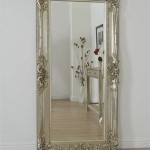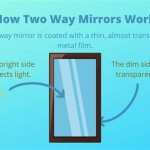How To Hang A Heavy Mirror On A Brick Wall
Hanging a heavy mirror on a brick wall presents a unique challenge compared to hanging it on drywall or plaster. Brick is a durable and rigid material, requiring specialized tools and techniques to ensure the mirror is securely mounted and remains in place. Improper installation can lead to the mirror falling, causing damage to the mirror, the wall, and potentially, personal injury. This article provides a detailed guide on how to safely and effectively hang a heavy mirror on a brick wall.
Before commencing the project, careful planning is crucial. This involves assessing the weight of the mirror, the condition of the brick wall, and gathering the necessary tools and materials. A thorough assessment will minimize the risk of errors and ensure a successful and secure installation.
Understanding the Challenges of Hanging on Brick
Unlike drywall, brick is not a uniformly solid material. It is composed of individual bricks held together by mortar. Drilling into the brick itself requires specialized drill bits and techniques to avoid cracking or damaging the brick. Furthermore, the mortar joints, while seemingly easier to drill into, may not provide sufficient holding power for heavy mirrors. The composition of the mortar can vary, and some mortars may be weaker and more prone to crumbling than others. Therefore, understanding the structural integrity of both the brick and the mortar is essential.
Another challenge lies in the weight distribution. Heavy mirrors exert a significant amount of downward force, which needs to be evenly distributed across the mounting hardware. Using inadequate anchors or improperly spaced mounting points can concentrate the weight on a small area, leading to failure. It is critical to select anchors that are rated for the weight of the mirror and to distribute the weight across multiple mounting points.
Finally, the aesthetic aspect must also be considered. Drilling into brick leaves permanent holes, which can be difficult to repair seamlessly. Careful planning and precise execution are necessary to minimize the impact on the appearance of the brick wall. Choosing the right location and using appropriate mounting hardware can help to preserve the aesthetic integrity of the wall.
Essential Tools and Materials
Successfully hanging a heavy mirror on a brick wall requires the right tools and materials. Using substandard equipment can compromise the security of the installation and potentially damage the brick wall. The following is a comprehensive list of essential tools and materials:
- Heavy-duty Hammer Drill: A standard drill is insufficient for drilling into brick. A hammer drill provides the necessary impact force to penetrate the hard material.
- Masonry Drill Bits: These bits are specifically designed for drilling into brick and concrete. Ensure the bit size matches the size of the anchors you will be using.
- Level: A level is crucial for ensuring the mirror is hung straight. A spirit level or a laser level can be used.
- Measuring Tape: Accurate measurements are essential for determining the placement of the mounting points.
- Pencil or Marker: Use a pencil or marker to mark the drilling locations on the brick wall.
- Safety Glasses: Protect your eyes from debris while drilling.
- Dust Mask: Brick dust can be harmful to breathe. A dust mask will protect your respiratory system.
- Heavy-Duty Anchors: Choose anchors specifically designed for brick and rated for the weight of the mirror plus a safety margin. Options include sleeve anchors, wedge anchors, and concrete screws.
- Screws: Use screws that are compatible with the chosen anchors and long enough to penetrate deep into the brick.
- Wall Hanging Hardware: This refers to the D-rings, wire, or other hardware already attached to the back of the mirror. Ensure these are securely attached and in good condition.
- Stud Finder (Optional): While not directly related to brick, a stud finder can be useful if the brick wall is part of a larger framed structure.
Investing in quality tools and materials is a crucial step in ensuring a safe and secure installation. Do not compromise on the quality of the anchors or drill bits, as these are essential for supporting the weight of the mirror.
Step-by-Step Installation Guide
Once you have gathered the necessary tools and materials, follow these steps to hang your heavy mirror on a brick wall safely and effectively:
- Preparation: Clear the area around the wall and protect the floor with a drop cloth. Wear safety glasses and a dust mask to protect yourself from debris.
- Mark the Location: Use a measuring tape and level to determine the desired location for the mirror. Mark the top edge of the mirror on the wall. Use the mirror's dimensions and mounting hardware locations to determine where to drill the holes for the anchors. Accuracy is crucial at this stage.
- Pilot Holes: Before drilling the final holes, it's advisable to drill pilot holes. Use a smaller masonry drill bit than the one required for the anchors. This will help prevent the drill bit from slipping and ensure accurate placement.
- Drill the Holes: Using the hammer drill and the appropriate size masonry drill bit, drill the holes at the marked locations. Drill straight into the brick, maintaining a consistent pressure. Drill the holes slightly deeper than the length of the anchors.
- Clean the Holes: Use a vacuum cleaner or compressed air to remove any dust or debris from the holes. This will ensure a proper fit for the anchors.
- Insert the Anchors: Insert the chosen anchors into the drilled holes. Follow the manufacturer's instructions for the specific type of anchor being used. Some anchors may require hammering in, while others may need to be tightened with a wrench. Ensure the anchors are flush with the wall surface.
- Attach the Mirror: Carefully lift the heavy mirror and align the mounting hardware with the installed anchors. Insert the screws through the mounting hardware and into the anchors. Tighten the screws until the mirror is securely attached to the wall. Do not overtighten the screws, as this could damage the anchors or the brick.
- Verify Stability: Once the mirror is installed, gently test its stability. Ensure it is securely attached to the wall and does not wobble or move. If there is any movement, double-check the anchors and screws to ensure they are properly tightened.
Following these steps carefully will help ensure a safe and secure installation of your heavy mirror on a brick wall. Take your time and double-check your work at each stage to minimize the risk of errors.
Choosing the Right Anchors
The selection of appropriate anchors is paramount when hanging a heavy mirror on a brick wall. Several types of anchors are available, each with its own strengths and weaknesses. The specific type of anchor chosen should be based on the weight of the mirror, the condition of the brick and mortar, and the desired level of permanence.
Sleeve Anchors: These anchors consist of a bolt surrounded by a sleeve. As the bolt is tightened, the sleeve expands, gripping the brick. Sleeve anchors offer excellent holding power and are suitable for heavy mirrors. They are relatively easy to install and provide a secure and reliable connection.
Wedge Anchors: Wedge anchors are designed for heavy-duty applications and provide exceptional holding power. They consist of a bolt with a wedge-shaped end. As the bolt is tightened, the wedge expands, anchoring the bolt securely into the brick. Wedge anchors are suitable for extremely heavy mirrors or mirrors that require a high level of security.
Concrete Screws: These screws are designed to be driven directly into concrete or brick without the need for a separate anchor. They have specialized threads that grip the brick securely. Concrete screws are a convenient option for lighter mirrors, but they may not provide sufficient holding power for very heavy mirrors.
Tapcon Screws: A brand name of concrete screws, Tapcon screws feature a specialized thread design that allows them to be driven directly into masonry materials, including brick. They offer a relatively easy installation process, eliminating the need for separate anchors in many cases. However, their holding power is generally less than that of sleeve or wedge anchors, making them suitable for lighter mirrors or when multiple screws can be used to distribute the weight.
It is crucial to consult the manufacturer's specifications for each type of anchor to determine its weight rating and suitability for the specific application. Always choose anchors that are rated for the weight of the mirror plus a significant safety margin. It is better to use anchors that are over-engineered than to risk the mirror falling.
Ultimately, success hinges on meticulous planning, the selection of appropriate tools and materials, and adherence to precise installation techniques. By understanding the challenges and following the outlined steps, one can confidently hang a heavy mirror on a brick wall, ensuring both safety and aesthetic appeal.

How To Hang A Heavy Mirror On Brick Fireplace Drill Into Dans Le Lakehouse

How To Hang A Heavy Mirror Securely Bob Vila

How To Hang A Large Wall Mirror Step By Tutorial

Quickest Way To Hang Mirror On Brick Wall

How To Hang A Large Or Heavy Mirror

How To Hang A Heavy Mirror On Brick Wall Hanging Tips Easy Tutorial Homify

How To Hang A Heavy Mirror Onto Gyproc Bunnings Work Community

How To Hang A Heavy Mirror On Brick Wall Hanging Tips Easy Tutorial Homify

How To Hang A Heavy Mirror On Brick Drill Into Hanging Pictures

3 Simple Ways To Hang A Mirror On Wall Without Nails Wikihow








